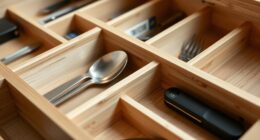To keep your freezer organized and prevent waste, clearly label all items with contents and purchase or expiration dates using airtight containers or freezer bags. Rotate older items to the front or top so you use them first, and discard any spoiled or expired foods promptly. Regularly update your inventory list during reorganizations to stay on top of what’s available. If you want to master effective labeling and rotation strategies, keep going to find out more tips.
Key Takeaways
- Label each item with contents, purchase date, and expiration date to track freshness and priority.
- Use clear, waterproof labels on containers or bags for easy identification during rotation.
- Organize items with older products at the front or top to ensure they are used first.
- Regularly review and update labels and inventory to maintain accurate stock and avoid spoilage.
- Implement a routine check to rotate stock, discard expired items, and keep the freezer orderly.

Keeping a freezer inventory is essential for managing your food storage efficiently. When you maintain an accurate list of what’s inside, you can streamline meal planning and reduce waste. Without a proper system, it’s easy to forget what you have or let food spoil, which can lead to unnecessary purchases and wasted money. Good storage techniques play a crucial role here; by organizing your freezer with clear labels and designated areas, you make it easier to locate ingredients quickly. Labeling items with dates and contents ensures you use older items first, supporting effective rotation and minimizing freezer burn. This way, you’re not only saving space but also extending the lifespan of your stored foods.
Maintaining a freezer inventory with clear labels and organization extends food freshness and reduces waste.
When it comes to meal planning, a well-maintained freezer inventory allows you to see at a glance what ingredients you have on hand. This eliminates the guesswork during busy weekdays or when you’re trying to decide what to cook. You can plan meals around what’s available, avoiding multiple trips to the store or impulsive buys. Keep a running list or a digital spreadsheet that details each item, its purchase date, and expiration date. This helps you prioritize what to use sooner and plan meals around those ingredients, which makes your shopping more targeted and efficient.
Applying proper storage techniques is vital for keeping your freezer organized and your food fresh. Use airtight containers or freezer bags with clear labels and dates. For smaller items, consider portioning out ingredients into meal-sized servings, so you can defrost only what you need. Group similar items together—vegetables, meats, leftovers—so you can quickly identify what you need without rummaging through everything. Rotating your stock involves moving older items to the front or top and placing new purchases behind them. This ensures you always use the oldest items first, maintaining freshness and reducing waste. Additionally, understanding mental wellbeing index can help motivate you to stay consistent with your organization routines, as it emphasizes the importance of mental health in overall wellbeing.
Furthermore, consistent labeling and rotation support better inventory management. Check your freezer regularly to update your list, discard spoiled items, and reorganize as needed. This habit helps you stay aware of what’s available, supports healthy meal planning, and keeps your freezer orderly. When your storage techniques are clear and systematic, you waste less food, save money, and enjoy the convenience of knowing exactly what’s stored. Ultimately, a strategic approach to labeling and rotation makes freezer management less of a chore and more of an effortless part of your overall kitchen routine.
Frequently Asked Questions
How Often Should I Check My Freezer Inventory?
You should check your freezer inventory weekly to guarantee items are within their expiration dates and to maintain proper labeling strategies. Regular inspections help you catch any spoiled food early and prevent waste. By staying consistent, you can organize your freezer better, rotate items efficiently, and avoid confusion. Keep a list or use labels to track expiration dates, making it easier to manage your inventory and avoid unnecessary trips or food spoilage.
What Is the Best Way to Store Leftovers?
Imagine you’re storing leftovers for a week’s meals. To keep food safe, use airtight containers and proper labeling techniques, including date and contents. Always let leftovers cool before sealing and placing them in the freezer. For ideal food safety, store leftovers in small portions to cool quickly and prevent bacteria growth. Clear labels help you track freshness, reducing waste and ensuring you enjoy safe, delicious leftovers whenever you want.
How Can I Prevent Freezer Burn on Food?
To prevent freezer burn, you should always use airtight containers or proper wrapping like plastic wrap and aluminum foil. Make sure all food is tightly sealed to minimize air exposure, which causes freezer burn. Remove excess air from bags before sealing, and store food at consistent, cold temperatures. These steps help protect your food’s texture and flavor, keeping it fresh longer and avoiding freezer burn.
What Is the Ideal Freezer Temperature for Preservation?
You should set your freezer to 0°F (-18°C) for ideal preservation. Using a thermometer guarantees accuracy because many freezers aren’t perfectly calibrated. Proper freezing techniques, like reducing the freezer’s temperature and avoiding frequent door openings, help maintain this perfect temperature. Regularly check your thermometer to prevent temperature fluctuations, which can lead to freezer burn or spoilage. Keeping your freezer at 0°F ensures your food stays fresh longer.
How Do I Organize Small or Bulky Items Efficiently?
To organize small or bulky items efficiently, use space-saving containers that fit tightly together, maximizing freezer space. Employ stacking techniques to create vertical layers, keeping frequently used items at the front for easy access. Group similar items together, label everything clearly, and rotate stock regularly. This approach guarantees your freezer stays organized, prevents clutter, and makes finding what you need quick and effortless, saving you time and maintaining ideal preservation.
Conclusion
Now that you’ve learned the importance of proper labeling and rotation, imagine opening your freezer and seeing a neat, organized space. Every item is clearly marked, and nothing is lost or forgotten. But what if you don’t keep up with it? The suspense lingers—hidden freezer burn, spoiled food, wasted money. Stay vigilant, stay organized. Your future self will thank you when you reach for that frozen meal, confident and stress-free, knowing everything is fresh and perfectly rotated.









